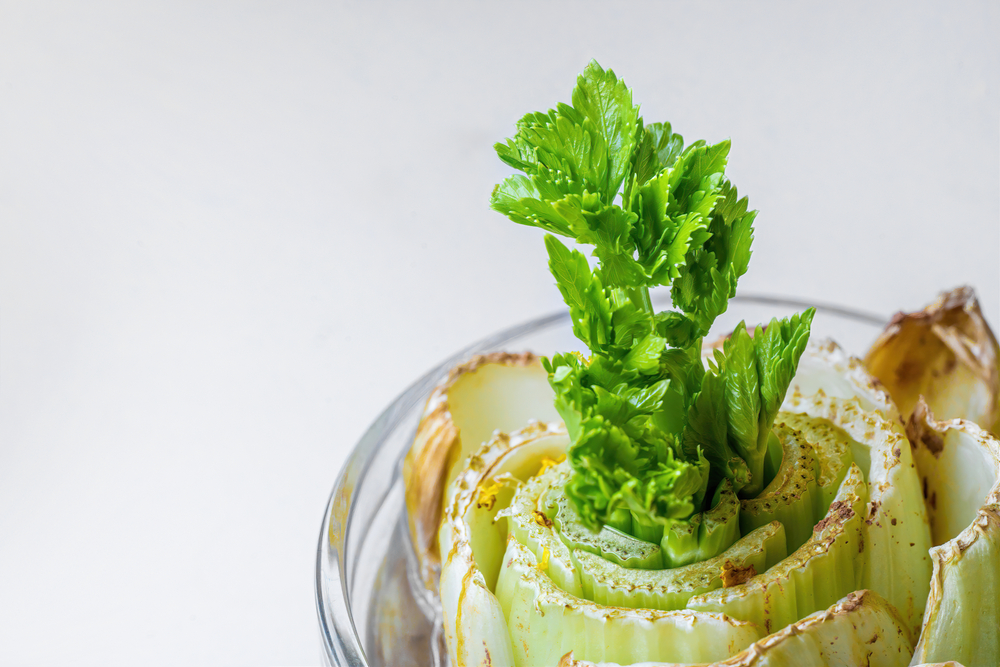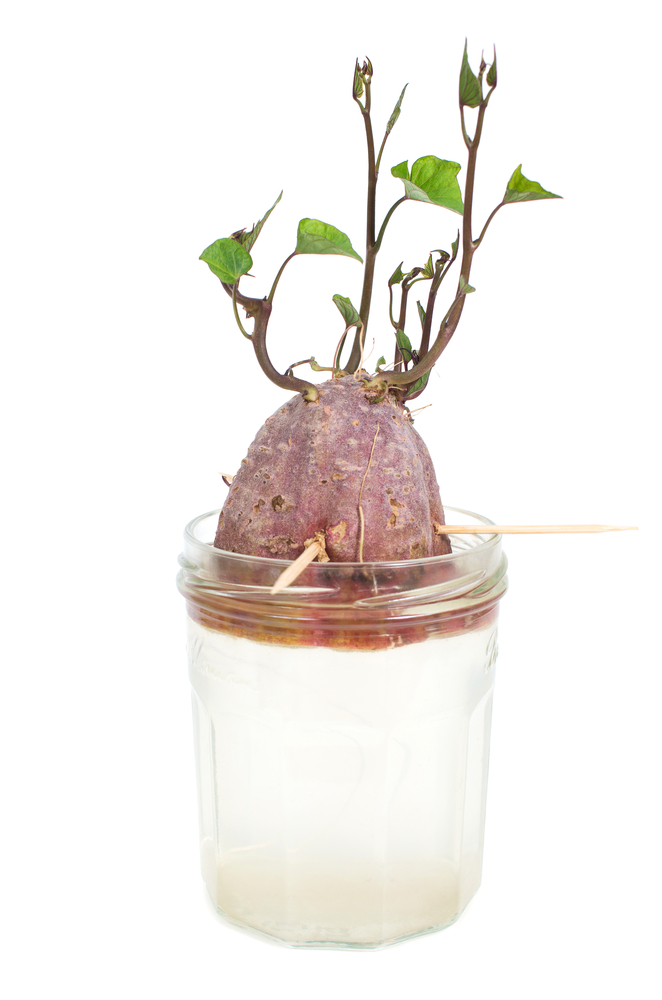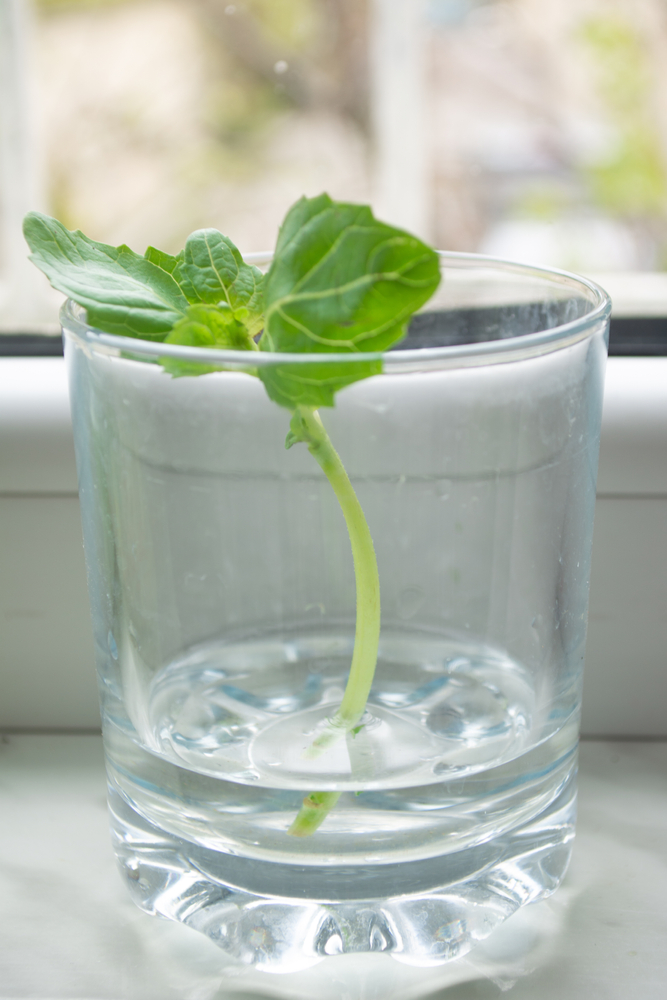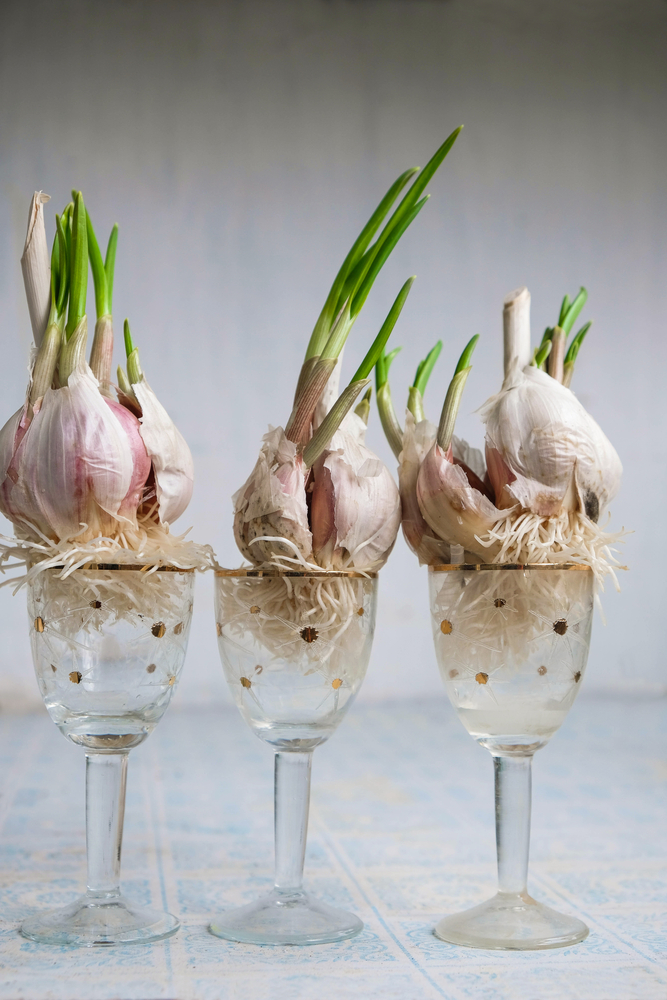5 Garden Edibles You Can Grow in Water
Save yourself some money and make use of your harvest’s odds and ends.
5 Garden Edibles You Can Grow in Water
Save yourself some money and make use of your harvest’s odds and ends.

Watch your harvest babies grow again. by Mehriban A on Shutterstock.
You may have heard the hype around spring onions and their ability to regrow with a touch of water. It’s a little life hack that can save you money and a trip to the store. Luckily, it’s not the only vegetable with these properties. We’ve assembled a list of five other plants and some basic instructions that will allow you to propagate your garden scraps. You don’t need another reason to leave the house right now, anyway.
Happy growing!
Lettuce
You’re going to have to use a head of lettuce, as its base will be where the new roots start to grow.
1) Cut off the base of your lettuce and place it in a glass of water or a bowl. You don’t want the lettuce fully submerged in the water, just about an inch to half of an inch to cover the bottom root area.
2) Leave it by a windowsill in the sunlight.
3) Every one to two days or when the water appears to look a little cloudy, change the water. You can rinse the lettuce with water as well each time you change the water. You will notice regrowth happens in the center of the lettuce, so there’s no need to panic if the perimeter leaves dry up a bit.
4) After about two weeks, you’ll notice some new leaves that have sprouted out of the top. You’ll also see that new roots have developed at the base of the lettuce and this means that it will be ready to be transferred into soil.

Celery
For celery, it’s important that you’re using a celery bunch and not an individual stalk. Just like if you were to regrow lettuce in water, the base of the bunch contains the roots.
1) Cut the bottom of your celery bunch about two to three inches from the bottom of the base.
2) Remove some of the older stalks on the perimeter of the bunch (only the outer three or four pieces).
3) Place the celery base in a cup, dish or bowl of water. The base should be immersed in water about one inch deep.
4) Change your water every three days or whenever you notice it starts to become cloudy.
5) After two weeks, you should notice some roots at the sides of the base. This means it is safe to be planted back into the soil (about one inch deep). To avoid transplant shock, ensure your soil is moist when planting.

Potatoes
1) Wash your potatoes to remove dirt, pesticides or any residue.
2) Cut the potato in half on its long side, but be careful not to cut through an eye (small dots on the potato skin) because that will later be germinating.
*If you don’t see eyes that have sprouted yet, leave them out near a window for a few days until they do.
3) Pierce four toothpicks about one fourth of the way into the top of the potato (where the skin is showing). Each toothpick should face in a different direction. It will look like an “x.”
4) Fill a glass of water and allow the cut side of the potato to be immersed. The toothpicks should be able to hold the top of the potato up on the lip of the glass.
5) Leave the potato in the glass in sunlight for about five or six hours each day for one to two weeks. Change your water when it gets cloudy.
6) Once your potatoes have roots, you can replant them in soil, root side down with the sprouts facing towards the sky.

Basil
1) Break off the lower leaves of the stem (about two inches from the bottom).
2) Put your basil stems inside your jar and add water.
3) Place the jar on your windowsill in bright, indirect sunlight.
4) Change the water every few days or when you notice it gets cloudy. It’s also important to monitor water levels. Add more to the jar if you need to in order to keep the stems immersed.
5) Let your roots grow to reach about two inches. This typically takes about 12 to 18 days.
6) Re-pot your stems with the roots in soil.

Garlic
For best results, use cloves that have already grown a small green sprout out of the tip.
1) Fill an empty cup or jar with a small amount of lukewarm water. It’s best to use a container that is clear so you can monitor growth.
2) Place your garlic inside the cup root side down with the pointy sprout part facing up towards the lip of the container. It’s important to note that the water should cover slightly over the root of the clove. It should not be completely submerged or else it will rot.
3) Place the cup on your windowsill in sunlight for seven days. If you notice that the green sprouts start to turn brown or wilt, take your container out of the sun for one to two days.
4) Change your water every few days when you notice that it starts to turn cloudy.
5) After about a week you should have extensive root growth and your garlic will be ready for replanting in soil. Ensure that your cloves are six inches apart when you replant.
Follow us
This work is licensed under a Creative Commons Attribution-NoDerivatives 4.0 International License.
Want to republish a Modern Farmer story?
We are happy for Modern Farmer stories to be shared, and encourage you to republish our articles for your audience. When doing so, we ask that you follow these guidelines:
Please credit us and our writers
For the author byline, please use “Author Name, Modern Farmer.” At the top of our stories, if on the web, please include this text and link: “This story was originally published by Modern Farmer.”
Please make sure to include a link back to either our home page or the article URL.
At the bottom of the story, please include the following text:
“Modern Farmer is a nonprofit initiative dedicated to raising awareness and catalyzing action at the intersection of food, agriculture, and society. Read more at <link>Modern Farmer</link>.”
Use our widget
We’d like to be able to track our stories, so we ask that if you republish our content, you do so using our widget (located on the left hand side of the article). The HTML code has a built-in tracker that tells us the data and domain where the story was published, as well as view counts.
Check the image requirements
It’s your responsibility to confirm you're licensed to republish images in our articles. Some images, such as those from commercial providers, don't allow their images to be republished without permission or payment. Copyright terms are generally listed in the image caption and attribution. You are welcome to omit our images or substitute with your own. Charts and interactive graphics follow the same rules.
Don’t change too much. Or, ask us first.
Articles must be republished in their entirety. It’s okay to change references to time (“today” to “yesterday”) or location (“Iowa City, IA” to “here”). But please keep everything else the same.
If you feel strongly that a more material edit needs to be made, get in touch with us at [email protected]. We’re happy to discuss it with the original author, but we must have prior approval for changes before publication.
Special cases
Extracts. You may run the first few lines or paragraphs of the article and then say: “Read the full article at Modern Farmer” with a link back to the original article.
Quotes. You may quote authors provided you include a link back to the article URL.
Translations. These require writer approval. To inquire about translation of a Modern Farmer article, contact us at [email protected]
Signed consent / copyright release forms. These are not required, provided you are following these guidelines.
Print. Articles can be republished in print under these same rules, with the exception that you do not need to include the links.
Tag us
When sharing the story on social media, please tag us using the following: - Twitter (@ModFarm) - Facebook (@ModernFarmerMedia) - Instagram (@modfarm)
Use our content respectfully
Modern Farmer is a nonprofit and as such we share our content for free and in good faith in order to reach new audiences. Respectfully,
No selling ads against our stories. It’s okay to put our stories on pages with ads.
Don’t republish our material wholesale, or automatically; you need to select stories to be republished individually.
You have no rights to sell, license, syndicate, or otherwise represent yourself as the authorized owner of our material to any third parties. This means that you cannot actively publish or submit our work for syndication to third party platforms or apps like Apple News or Google News. We understand that publishers cannot fully control when certain third parties automatically summarize or crawl content from publishers’ own sites.
Keep in touch
We want to hear from you if you love Modern Farmer content, have a collaboration idea, or anything else to share. As a nonprofit outlet, we work in service of our community and are always open to comments, feedback, and ideas. Contact us at [email protected].by Lindsay Campbell, Modern Farmer
May 30, 2020
Modern Farmer Weekly
Solutions Hub
Innovations, ideas and inspiration. Actionable solutions for a resilient food system.
ExploreExplore other topics
Share With Us
We want to hear from Modern Farmer readers who have thoughtful commentary, actionable solutions, or helpful ideas to share.
SubmitNecessary cookies are absolutely essential for the website to function properly. This category only includes cookies that ensures basic functionalities and security features of the website. These cookies do not store any personal information.
Any cookies that may not be particularly necessary for the website to function and are used specifically to collect user personal data via analytics, ads, other embedded contents are termed as non-necessary cookies.
your potato picture is a sweet potato!